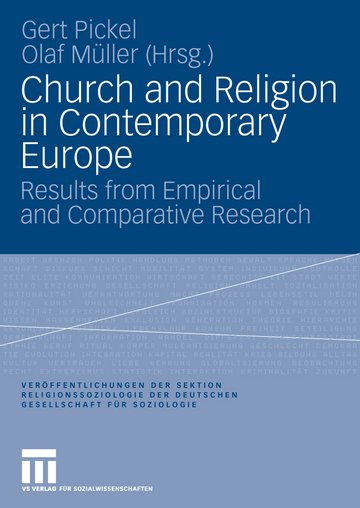| Content | 6 |
| Introduction – The Comparative View on Religion and Religiosity | 7 |
| 1. Religion and religiosity from an empirical and comparative perspective: research deficits and improvements | 7 |
| 2. Underlying theoretical approaches: secularization, individualization, and the market approach | 8 |
| 3. About the book | 9 |
| 4. Literature | 12 |
| Why, at all, do we need Religion? Religion and Morality in Post- Communist Europe | 13 |
| 1. Revitalisation of religion in post-communism: causes and consequences | 13 |
| 2. Gods, rituals and the moral order: the recent lesson by Rodney Stark | 14 |
| 3. Religion and morality in post-communism: are non-existent ties still present in the late ‘ 90s? | 15 |
| 4. Moral statements: religious and/or cultural norms? | 16 |
| 5. Influence of religion on family/private life and public domain: an alternative explanation | 22 |
| 6. References | 24 |
| Religious Pluralism and Dimensions of Religiosity: Evidence from the Project Religious and Moral Pluralism ( RAMP). | 25 |
| 1. The RAMP-project | 25 |
| 2. Religious options | 26 |
| 3. Conclusion | 32 |
| 4. References | 34 |
| Religiosity in Europe and in the Two Germanies: The Persistence of a Special Case – as revealed by the European Social Survey1 | 35 |
| 1. Design of research | 35 |
| 2. Results: church membership | 38 |
| 3. Results: service attendance | 40 |
| 4. Results: frequency of prayer | 43 |
| 5. Results: self-ascribed religiosity | 45 |
| 6. Summary and conclusion | 47 |
| 7. References | 48 |
| Religion in Finland and Russia in a Comparative Perspective | 49 |
| 1. Introduction | 49 |
| 2. Religious change in Finland | 49 |
| 3. Religious change in Russia | 56 |
| 4. Conclusion | 61 |
| 5. References | 63 |
| Religiosity in Central and Eastern Europe: Results from the PCE 2000 Survey in Comparison | 64 |
| 1. Introduction | 64 |
| 2. Theoretical framework | 67 |
| 3. Data and indicators | 69 |
| 4. Church adherence and traditional religiousness: revival or decline? | 70 |
| 5. Religious “alternatives”: towards individualization? | 75 |
| 6. Traditional and alternative religiousness: patterns and correlations | 77 |
| 7. Conclusion | 79 |
| 8. References | 80 |
| Annex: Description of indicators | 83 |
| Secularization as a European Fate? – Results from the Church and Religion in an Enlarged Europe Project 2006 | 88 |
| 1. Introduction – the persistence of an out-dated approach | 88 |
| 2. The theoretical prerequisites | 89 |
| 3. Case selection and measurement | 94 |
| 4. Societal secularization | 97 |
| 5. Religiosity 2006 – an indication of individual secularization? | 99 |
| 6. Secularization, individualization, and the market model | 105 |
| 7. Bases of religious vitality | 110 |
| 8. Summary – a contextualized theory of secularization | 114 |
| 9. References | 118 |
| Religious Oddities: Explaining the Divergent Religious Markets of Poland and East Germany | 122 |
| 1. Introduction | 122 |
| 2. Deductive theory | 124 |
| 3. Case analyses | 127 |
| 4. Discussion | 138 |
| 5. Conclusion | 140 |
| 6. References | 141 |
| Church-State Relations and the Vitality of Religion in European Comparison | 144 |
| 1. Preliminary theoretical considerations | 144 |
| 2. Operationalizing the questions and the problems this entails | 147 |
| 3. Overview of the distribution of the main variables | 149 |
| 4. Attempt at an explanation | 153 |
| 5. Conclusion | 161 |
| 6. References | 162 |
| Appendix: Additional Charts | 164 |
| European Exceptionalism: Lazy Churches, Pluralism, Adherence and the Case of the Dutch Religious Cartel | 166 |
| 1. Ecumenical charter or church cartel? | 166 |
| 2. Religious market and adherence | 167 |
| 3. Dutch religious market: free and pluralistic - decline of adherence | 169 |
| 4. Absence from competition | 175 |
| 5. Pluralism + freedom (necessarily) competition | 177 |
| 6. References | 179 |
| Religion, Popular Piety, Patchwork Religion | 182 |
| 1. Transition: the pilgrim and the patchwork religion | 182 |
| 2. The hypotheses | 182 |
| 3. Patchwork religion = religion + a little something else | 183 |
| 4. Further precision: religion and magic | 185 |
| 5. The field study: on the history and topography of the Bregenz Forest | 185 |
| 6. Early christianization and its traces | 186 |
| 7. Metamorphosis 1: the hazelnut | 188 |
| 8. Metamorphosis 2: the sources | 190 |
| 9. The modern age between everyday magic and heresy | 191 |
| 10. Changes in the patterns of interpretation of traditional everyday magic | 196 |
| 11. Everyday magic and postmodern patchwork religion | 198 |
| 12. References | 200 |
| Authors | 202 |


















